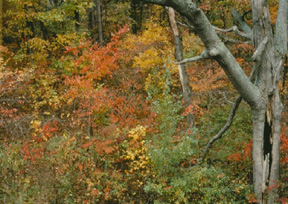Shades of Autumn
By Kathy Reshetiloff
Autumn always seems to sneak up
on us. Finally, drier days
and cooler nights replace the heat and humidity of summer. Here
and there, we glimpse autumn colors peeking out of the green landscape.
Then just as we're beginning to enjoy them, those warm hues are
replaced by dismal browns as leaves carpet our lawns and gardens.
 Actually this leaf shedding process, known as abscission, has
been occurring for several weeks. Cells, located at the spot where
the leaf stem is attached to the tree, toughen and begin to form
a protective waterproof scar. The cells in the leaf stem itself
swell, weaken and degenerate. This interferes with the flow of
moisture and nutrients into the leaf, reducing the production
of a pigment, known as chlorophyll, which gives leaves their green
color.
Actually this leaf shedding process, known as abscission, has
been occurring for several weeks. Cells, located at the spot where
the leaf stem is attached to the tree, toughen and begin to form
a protective waterproof scar. The cells in the leaf stem itself
swell, weaken and degenerate. This interferes with the flow of
moisture and nutrients into the leaf, reducing the production
of a pigment, known as chlorophyll, which gives leaves their green
color.
The leaf is the food factory for the tree. Chlorophyll in a leaf
uses the sun's energy to convert
carbon dioxide and water into sugar, food for the tree. As the
days shorten, there is less sunlight energy to manufacture food.
Nutrients and minerals are withdrawn from leaves and transported
to the permanent parts of trees such as the trunk, stems, and
roots. Chlorophyll breaks down. But leaves also contain other
pigments that give them their fiery fall colors. These other colors
are hidden most of the year by the abundance of chlorophyll, making
leaves appear green. Leaves reveal their autumn colors as chlorophyll
breaks down and other pigments are unmasked.
Xanthophyll produces the color yellow and carotene, like that
in carrots, produces yellow-orange. Leaves continue to produce
sugar during the day but cold night temperatures prevent trees
from withdrawing the food out of the leaves. Sunny days and cool
nights can produce a sugar-related pigment, anthocyanin, which
produces fiery reds. Other chemicals and breakdown products produce
bronze, purple, and crimson. Birches, beeches and tulip poplars
turn golden. Sassafras trees take on an orange tone. One of the
more colorful trees, the sugar maple, may assume a yellow, orange,
or red color or any combination of these hues.
The red maple and staghorn sumac are two of the more vibrant red
trees. Vines such as Virginia creeper and poison ivy also turn
crimson. The oaks turn a variation of yellow, orange or bronze.
Leaves stay on oaks the longest and it is often their dry leaves
that you hear rustling in the breeze.
The final step in the abscission process occurs when a tree sheds
its leaves. Gradually, the bond between leaves and a tree weakens.
The tiny veins that carried sap to the leaves all summer long
are sealed off. Leaves then fall to the ground encouraged by wind
or by the sheer weight of gravity. Now the dominant color is brown
as the chemical reaction of decomposition starts.
Dry, brown decaying leaves may not be beautiful, but they are
valuable. Instead of bagging leaves, try composting them. It's
the most ecological and economical (and least labor intensive)
way to dispose of them.
As the leaves decompose, they release nutrients back into the
soil. If you have a mulching mower, leaves can be cut into smaller,
faster-decomposing pieces. Mulched leaves can be left on lawns
and will actually enhance the soil, reducing the need to fertilize
your yard next spring.
Spread whole leaves around vegetable gardens, flowerbeds, bushes
and trees. The leaves also form an insulating barrier around plants,
reducing moisture loss and damage from severe winter weather.
By putting whole and composted leaves on yards and gardens, you
reduce the need to fertilize. This cuts down on the amount of
nutrients that runoff the land into streams and rivers and, ultimately,
the Chesapeake Bay.
Kathy Reshetiloff is employed by the U.S. Fish and Wildlife Service, U.S. Department of the Interior. Photo by Rich Mason, U.S. Fish and Wildlife Service.
|
Back
|

